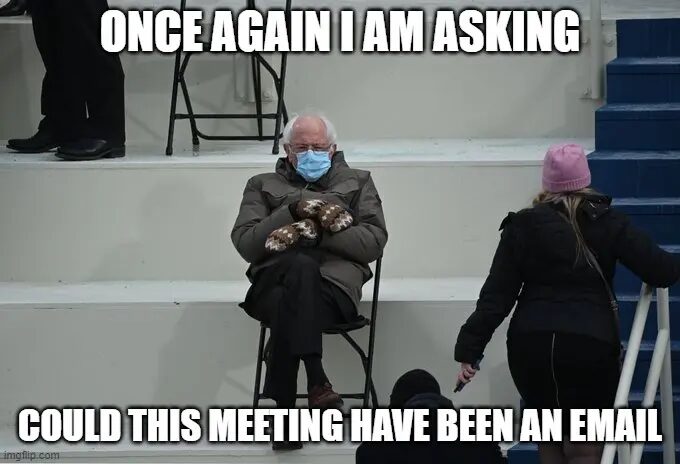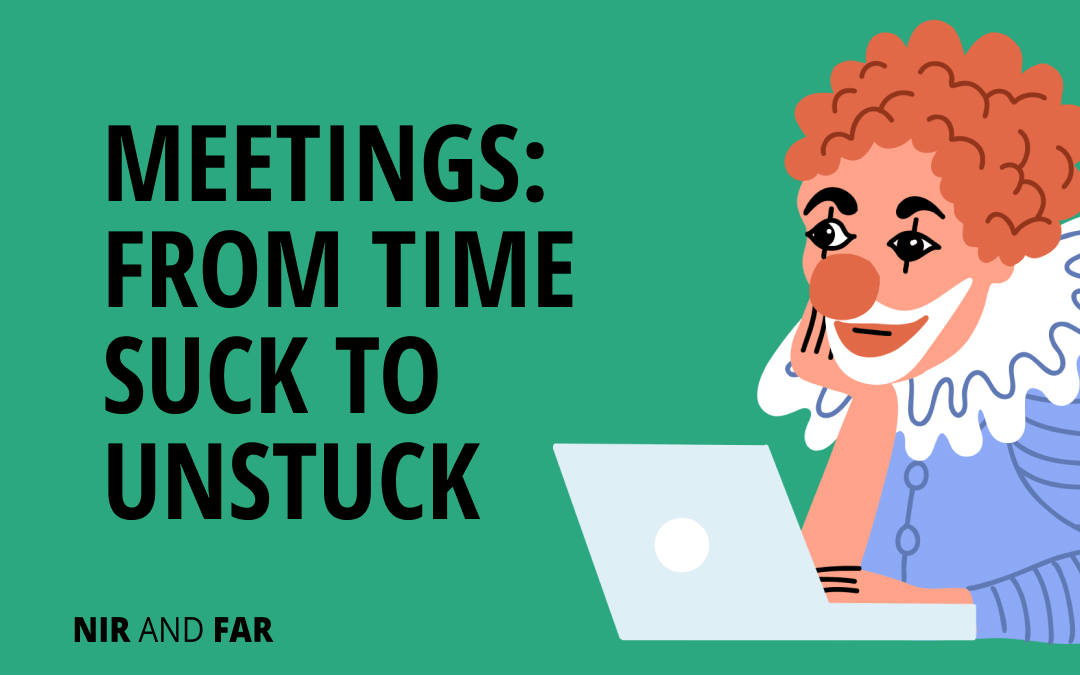We’ve all been in a meeting that made us think, “This doesn’t even apply to me,” “I’m learning nothing from this,” or worst of all, “This meeting could have been an email.”
I’m sure you’ve commiserated with colleagues over what a time suck dumb meetings can be.
Still, you might have resigned yourself to dumb meetings, accepting them as an inevitable facet of the workplace.
But dumb meetings are not inevitable; they’re totally avoidable.
Dumb meetings are a sign of a dysfunctional workplace. And it doesn’t have to be that way!
Here’s how to recognize when a meeting is unnecessary and actionable tips to reduce them in your workplace.
The Significance of the “This Meeting Could Have Been an Email” Meme

The “This Meeting Could Have Been an Email” meme strikes a chord with so many because it exposes a widespread workplace inefficiency: the overuse of meetings for information that could be easily shared via email. It underscores the critical need to respect employees’ time and adopt better communication strategies. This meme has become a rallying cry for frustrated employees, highlighting the urgent need to have fewer meetings and have more efficient and thoughtful communication in the workplace.
Why Pointless Meetings Are Bad for Business
Unnecessary meetings are expensive. Not only do superfluous meetings drain morale, but also they cost a bundle in lost productivity.
A one-hour meeting of five people with an average salary of $100,000 costs $350. Multiplied by the hundreds (if not thousands) of hours wasted in dumb meetings, the cost adds up.
Even that figure is underestimated as attendees typically stop working on tasks 15 to 20 minutes before the meeting—virtual ones included—and lose time refocusing on tasks after the meeting, a common effect of task switching. Employees who attend several meetings daily task-switch repeatedly and struggle to keep up with the schedule, resulting in never having an uninterrupted swathe of time for focused work. Many people also find themselves driven to distraction during these liminal moments, or transitions from one thing to another throughout the day.
It’s no wonder that Harvard Business Review said, “time is an organization’s scarcest—and most often squandered—resource.” Dumb meetings are a drain on productivity. To stop frivolously spending a resource as precious as time, organizations have to limit their idea of what constitutes a meeting.
What Are Meetings For, Anyway?
The sole purpose of a meeting is to gain consensus. That is it!
To understand what necessitates a meeting or not, and effectively learn how to have fewer meetings, separate information dissemination into two categories: synchronous and asynchronous.
Synchronous communication, or the exchange of information in real-time, like meetings, should be reserved exclusively for making a decision. Meetings aren’t the beginning of a decision-making process; they’re the end. During meetings, the team ensures all relevant facts have been considered and commits to a course of action. Everything before the meeting should happen asynchronously.
Asynchronous communication includes a lag between when someone sends a message and when the receiver reads and reacts to it, such as emails and Slack messages. Information dissemination should happen through asynchronous communication, where people can absorb and digest the facts in their own time.
To clarify, meetings are not:
- Social engagements
- Company announcements
- Brainstorming sessions
Fostering a positive company culture is essential, but socializing should be its own thing; it’s not a business meeting. Company announcements can easily be sent over email. No one needs to hear a colleague say things out loud that could have been read in an email in their own time. And brainstorming sessions are one of the biggest culprits for ineffective meetings.
If brainstorming sessions are conducted in person, they should be in groups of four (or fewer) people. Why not a big group? First, when you gather several people for brainstorming, the loudest, highest-paid, and most dominant person, usually male, tends to dominate the conversation. Everyone else gets drowned out. And what’s the point of hiring employees only to overlook their professional opinions?
Second, big brainstorming groups are significantly less productive than individuals left to brainstorm alone. That’s why a better approach for brainstorming is to email people the problem and ask them to reply with their thoughts and suggestions by a specific deadline.
If you’re unsure whether your problem necessitates a meeting, follow this protocol as a key office productivity tip. Better yet, suggest to your manager that this protocol be implemented company-wide.
5 Signs Your Meeting Should Have Been an Email
Not all meetings are created equal. Some are necessary for decision-making and collaboration, while others end up wasting valuable time and resources. To help you determine whether your meeting is worth having or if it should be replaced by an email, consider these five key signs. This approach is central to learning how to have fewer meetings, ensuring that you only schedule gatherings that are truly necessary and productive.
- No Agenda: If there’s no clear agenda, the meeting is likely unnecessary. Meetings should always have a specific purpose and structure.
- Information Dissemination: If the primary goal is to share information without requiring discussion, it should be done asynchronously. Send an email instead.
- Routine Updates: Regular updates that don’t require a group discussion are better suited for an email. Asynchronous communication can handle these updates efficiently
- Low Engagement: If most participants are not actively engaged, the meeting is not adding value and can likely be replaced by an email.
- Lack of Decision-Making: If no decisions are being made, it’s a strong indication that the meeting is unnecessary. Meetings should be the final step in the decision-making process, not just a status update.
How to Reduce Meetings in the Workplace
- Implement a Meeting Policy: Establish clear criteria for when meetings are necessary. Meetings should be rare and only called to gain consensus. Ensure everyone understands these guidelines.
- Encourage Asynchronous Communication: Utilize tools like Slack, Microsoft Teams, and collaborative documents to facilitate communication without the need for meetings. Disseminate information asynchronously to avoid unnecessary meetings.
- Set a High Bar for Scheduling Meetings: Require a detailed agenda and pre-meeting preparation. No agenda, no meeting. Ensure meetings have a clear purpose focused on decision-making.
- Limit Meeting Length and Frequency: Keep meetings short and infrequent. Stand-up meetings can be an effective way to keep discussions brief and focused.
- Adopt Alternative Communication Methods: For quick updates and check-ins, use asynchronous methods or brief huddles to avoid unnecessary meetings.
How to Determine If a Meeting Is Necessary
Organizations should have a very high bar for synchronous communication as part of a broader strategy on how to reduce meetings in the workplace. Meetings should be rare, as they should only be called to gain consensus. And the party calling the meeting should complete three steps before the meeting can happen:
- Meeting organizers must disseminate relevant information and ask for feedback through asynchronous channels before scheduling a meeting.
- Organizers must circulate an agenda for the meeting, structuring how attendees will address the problem. No agenda, no meeting.
- They have to give their best shot at a solution in the form of a brief, written digest. The digest need not be more than a page or two discussing the problem, their reasoning, and their recommendation.
These steps require more effort upfront, but that’s precisely the point. Calling meetings today is too easy, and that’s why we have too many of them. Getting everyone up to speed, asking for their input, circulating an agenda, and preparing a briefing document not only saves everyone time by getting to the point faster but also ensures only the most essential meetings happen.
Cutting down on “this meeting could‘ve been an email” gripes is just one of many steps that managers can take to fix distractions in the workplace.
Free Schedule Maker Template
Take back control of your time and design your ideal day.
Your email address is safe. I don't do the spam thing. Unsubscribe anytime. Privacy Policy.

Related Articles
- Schedule Maker: a Google Sheet to Plan Your Week
- Habit Tracker Template in Google Sheets
- The Ultimate Core Values List: Your Guide to Personal Growth
- Timeboxing: Why It Works and How to Get Started in 2024
- An Illustrated Guide to the 4 Types of Liars
- Hyperbolic Discounting: Why You Make Terrible Life Choices
- Happiness Hack: This One Ritual Made Me Much Happier

